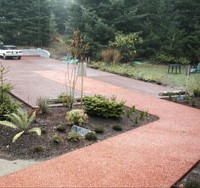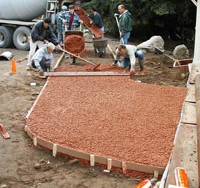Pervious Concrete Flatwork
Putting a Pretty Face on Pervious Concrete
In the 1960s, when pervious concrete pavement first made its appearance in North America, it simply didn’t catch on widely. Over the next several decades, while there were many installations of these pavements, they were localized to certain regions.
In today’s environmentally conscious climate, the benefits of pervious concrete to sustainability have reinvigorated interest in these free-draining pavements. And though it’s appealing for its technical benefits, pervious concrete hasn’t necessarily been attractive…until now. Renewed attention to pervious pavements has led some people to experiment with improvement of the surface aesthetics—and spawned a new type of concrete sometimes referred to as “architectural pervious concrete” (APC).
Most pervious concrete has a sort of popcorn look about it: Uniformly sized aggregate, falling within a narrow aggregate gradation, leads to a concrete with open void areas that promote fast drainage of large volumes of water. Some like the organic, rough-textured look of plain pervious concrete. But for those who want a different look, there are several options for enhancing the aesthetics. Treatments include color, stamping, jointing, and grinding.
This test panel is made with architectural pervious concrete containing 100 percentfines—no coarse aggregate—and as a result, the surface can accommodate a stamped finish.
This APC cylinder shows that the material has a smooth texture that is fine enough to be stamped yet still absorptive.
Grinding the surface of traditional pervious concrete pavement creates a smoother finish and an interesting texture.
Color is a fairly simple addition to pervious concrete: Mineral pigments mixed with gray or white cement give an overall color to the paste, which coats aggregate particles. Color works with both traditional pervious concrete and APCs. APCs are typically made with some or even 100% fine aggregate. While mixes that contain fines do not have the same large void structure as traditional pervious, they are still absorptive enough to keep walkways dry and recharge ground water. APCs allow for smoother, stampable finishes, unlike traditional pervious concrete. Pervious concretes that contain fines are safer for walking in any kind of shoes, including high heels. Traditional pervious, which cannot be stamped, can be ground to provide a smoother surface—and a different appearance.
Mixtures require the use of a special admixture that allows the addition of a high percentage of fine aggregate, even as much as 100 percentfines. The admixtures stabilize the air voids in the mixes to maintain adequate infiltration rates. Some APCs act a little like a sponge: It absorbs water and holds it, allowing some to percolate into the ground and as much as 40 percentto evaporate back to the atmosphere. That is different from traditional pervious. Some admixtures supposedly have both strengthening and self-consolidating properties for added workability and ease of placement.
The California and Nevada Cement Association (CNCA) also weighs in on decorative treatments for pervious concrete pavements. They note that integral coloring agents can be added to the mix or water-based concrete stains can be sprayed onto the surface after installation. CNCA recommends against the use of solvent-based coatings or sealers because these materials can clog voids in the pavement. Although patterns can’t easily be stamped into traditional pervious concrete—it’s too stiff and doesn’t have the right texture—it is possible to score decorative lines into the surface.
Traditional Pervious Concrete
Aggregate Flexural Strength, psi
(limited fine aggregate) 150 to 550
4.75 to 19.0 mm or
1.18 to 9.5 mm or
0.300 to 9.5 mm
Strength, psi Percolation Rate, inches/hour
500 to 4,000 288 to 770
(average 2,500) (up to 1,650 measured in the lab)
Colored Pervious Arrives in Washington State
In 2006, the City of Sultan, Wash. completed a 20-home residential demonstration project. Stratford Place included 800 cubic yards of pervious concrete to pave 32,000 square feet, replacing traditional concrete for a road, connecting driveways, and associated sidewalks. Integral color was added to the sidewalk mix. Tinting the concrete not only improved the appearance of the walkways, it delineated then. Because curbs and gutters are not necessary for storm water control with pervious pavements, the color difference visually separates the road from the sidewalk, making the road safer for pedestrians.
This was only the second public road in Washington State to be built with pervious pavement. Besides the storm water benefits, using pervious pavement saved two lots for development, which would otherwise have been needed for use as catch basins and vaults. Doing away with the traditional storm water system and related items ultimately saved the developer money and was better for the environment. Rick Cisar, Sultan engineer, was so impressed with the Stratford Place results that he plans to use pervious pavement for a city street. He says pervious pavement resolves drainage problems, protects critical areas and stream corridors, and helps to protect adjacent properties from encroaching storm water.
Another project in Washington State was a residence on Whidby Island. The use of two colored pervious concrete mixes for a small access road and parking area really improved the appearance of the pavement.


References
ACI 522, Pervious Concrete, ACI Committee Report 522R-06, The American Concrete Institute, Farmington Hills, MI, 2006, 25 pages. (This provides technical information on pervious concrete's application, design methods, materials, properties, mixture proportioning, construction methods, testing, and inspection.)
Davis, Kelly, “Learning Your APCs,”Concrete Producer Magazine, Hanley-Wood LLC, Addison, IL, September 2006, 5 pages.
Stormwater Management with Pervious Concrete Pavement (IS334P), American Concrete Pavement Association, Skokie, IL, 2006, 6 pages.
Tennis, Paul D., Leming, Michael L., Akers, David J., Pervious Concrete Pavements, EB302, Portland Cement Association, Skokie, Illinois, 2004, 36 pages.